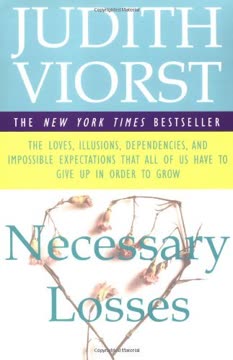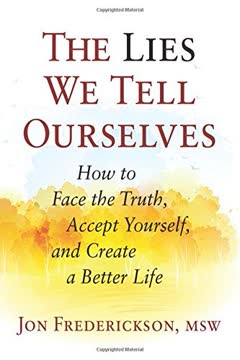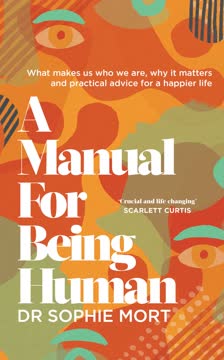Key Takeaways
1. Loss is Inherent to Life and Growth
And these losses are necessary because we grow by losing and leaving and letting go.
Universal experience. Loss is not merely the absence of something, but a fundamental aspect of the human condition. It encompasses death, separation, change, and the relinquishing of dreams and illusions. This perspective broadens our understanding of loss beyond the tangible and immediate.
Growth through renunciation. Human development is paved with renunciation. We grow by giving up attachments, cherished parts of ourselves, and impossible expectations. This process of renunciation, though painful, is essential for personal evolution and maturity.
Loss shapes us. Our responses to loss experiences determine the people we become and the lives we lead. Understanding how we deal with loss is central to understanding our lives, as it shapes our expectations, relationships, and overall worldview.
2. The Yearning for Oneness vs. the Necessity of Separation
For he on honey-dew hath fed, And drunk the milk of Paradise.
Original bliss. The ultimate mother-child connection represents a state of oneness, a "harmonious interpenetrating mix-up" that we yearn to recapture throughout our lives. This pursuit of connection can manifest in various forms, from sexual intimacy to religious experiences.
The price of individuality. While the desire for union persists, the road to human development is paved with renunciation. Giving up this world-embracing oneness is a necessary loss, as it allows us to develop a distinct sense of self and navigate the world as individuals.
Constructive regression. Experiences of oneness can provide respite from the solitude of separateness and help us transcend our former limits. "To merge in order to reemerge" can be part of the fundamental process of psychological growth, enriching and enhancing our sense of self.
3. Building a Separate Self: A Lifelong Project
There is no ache more Deadly than the striving to be oneself.
Separation-individuation. The journey from oneness to separateness is a gradual unfolding, marked by predictable stages of differentiation, practicing, and rapprochement. These stages involve both physical and emotional separation from the mother.
Rapprochement crisis. The rapprochement stage presents a dilemma: how to balance the desire for autonomy with the need for connection and safety. This crisis shapes our subsequent relationships and our ability to stand alone.
Internal world. By the end of our second year, we begin to stabilize our inner pictures of ourselves and others, integrating good and bad qualities into a more realistic and enduring sense of self. This process, though never fully complete, is essential for healthy development.
4. Love, Hate, and the Human Connection
For love … is the blood of life, the power of reunion in the separated.
Love and separation. While being a separate self is glorious, it can also be lonely. Love serves as a bridge between separate selves, reconciling oneness and separateness through human connection.
The presence of hate. Even in the tenderest love relations, a small portion of hostility adheres. Acknowledging our aggression is not an argument for brutality, but a recognition of the complex and often contradictory nature of human emotions.
Lessons from parents. Our mother gives us our earliest lessons in love and hate, while our father elaborates on them, offering an alternative to the mother-child relationship and fostering autonomy and individuation.
5. The Oedipus Complex: Navigating Forbidden Desires
Psychic reality will always be structured around the poles of absence and difference; and … human beings will always have to come to terms with that which is forbidden and that which is impossible.
Universal longings. The Oedipus complex involves a passionate longing to possess one parent sexually and eliminate the other. These longings are forbidden and impossible, leading to guilt and a terror of reprisals.
Resolution through identification. We resolve our oedipal conflicts by renouncing our sexual love for the opposite-sex parent and identifying with the same-sex parent. This process shapes our gender identity and our moral compass.
Consequences of failure. Failure to resolve oedipal conflicts can lead to various psychological difficulties, including a compulsion to repeat early patterns in adult relationships and a fear of success.
6. Anatomy, Destiny, and Gendered Expectations
When you meet a human being, the first distinction you make is “male or female?”
Sex-linked limits. The mere fact of inhabiting a male or female body importantly defines and confines our experience. This recognition of sex-linked limits is another necessary loss.
Innate differences. While cultural influences play a significant role, there are also biological predispositions that shape our behavior and abilities. For example, boys are generally more aggressive, while girls have greater verbal ability.
Gender identity. The process of establishing gender identity differs for boys and girls, with boys needing to break more sharply from the mother tie. This can lead to anti-female defenses and a fear of intimacy.
7. Guilt: A Necessary Evil for a Moral Life
Without guilt What is man? An animal, isn’t he?
The role of conscience. Guilt becomes our own when we develop a superego, an internal critical voice that enforces moral restraints and ideals. This conscience, though limiting, is essential for civilized behavior.
Appropriate vs. inappropriate guilt. There is good and bad, appropriate and inappropriate guilt. Excessive guilt, such as indiscriminate guilt or disproportionate punitiveness, can be detrimental to our well-being.
Deficient guilt. A lack of guilt can be equally problematic, leading to antisocial behavior and a disregard for the well-being of others. A healthy conscience strikes a balance between moral restraint and personal freedom.
8. Adolescence: A Crucible of Identity and Loss
To be a man is, precisely, to be responsible.
Leaving childhood. Adolescence marks a transition from the safety of family life to the wider world. This phase involves acquiring social and psychological skills, as well as confronting new challenges and responsibilities.
Identity crisis. Adolescence is characterized by an identity crisis, a struggle to define who we are and what we want to be. This process involves integrating various aspects of our self and making choices about our future.
Mourning childhood. Adolescence also involves mourning the loss of childhood, including its innocence, simplicity, and sense of limitless possibilities. This mourning is essential for emotional growth and maturity.
9. The Imperfect Nature of Human Connections
We are all of us calling and calling across the incalculable gulfs which separate us….
Friendship's complexities. Friendships, like all relationships, are marked by ambivalence, competition, and the limitations of human nature. Even the best of friends are "friends in spots," offering only partial fulfillment of our needs.
Types of friendships. Different types of friendships serve different purposes, from convenience friends who provide practical support to close friends who offer deep emotional intimacy. Each type plays a valuable role in our lives.
The value of imperfection. Despite their imperfections, human connections are essential for our well-being. They provide support, pleasure, and opportunities for personal growth, enriching our lives in ways that solitude cannot.
10. Aging, Acceptance, and the Meaning of Mortality
This is what age must learn about: The ABC of dying.
Confronting mortality. Old age brings a new set of challenges, including physical decline, loss of loved ones, and a growing awareness of our own mortality. How we respond to these challenges shapes the quality of our final years.
Shifting perspectives. While aging involves losses, it can also bring new perspectives, freedoms, and opportunities for growth. By embracing the present moment and finding meaning in our experiences, we can transcend the limitations of age.
The end of mourning. The process of mourning, though painful, can lead to acceptance, adaptation, and a renewed appreciation for life. By letting go of what we must, we can find peace and fulfillment in our final years.
Last updated:
FAQ
What is Necessary Losses by Judith Viorst about?
- Central theme of loss: The book explores the essential losses—loves, illusions, dependencies, and impossible expectations—that everyone must face to grow emotionally and psychologically.
- Developmental journey: Viorst traces how loss shapes us from infancy through old age, including separation from parents, relinquishing fantasies, and confronting mortality.
- Psychoanalytic perspective: Drawing on Freud and other theorists, the book examines how unconscious processes and early experiences influence our ability to handle loss.
- Universal relevance: The narrative weaves personal stories, clinical insights, and literary references to show that loss is a fundamental part of the human condition.
Why should I read Necessary Losses by Judith Viorst?
- Profound emotional insight: The book offers deep understanding of how loss is intertwined with growth, helping readers make sense of their own emotional struggles and transitions.
- Practical wisdom: Viorst provides tools for coping with separation, grief, and the challenges of intimacy and autonomy, encouraging acceptance and hopeful change.
- Validation and comfort: By normalizing ambivalence, imperfection, and grief, the book reassures readers that these experiences are universal and necessary for maturity.
- Broad application: Its themes resonate for anyone navigating family, friendships, love, aging, or personal growth.
What are the key takeaways from Necessary Losses by Judith Viorst?
- Growth requires letting go: Emotional and psychological development is fundamentally linked to giving up attachments, illusions, and impossible expectations.
- Ambivalence is normal: Love and hate coexist in all close relationships, and accepting this complexity is crucial for mature connections.
- Losses are lifelong: From childhood separations to the acceptance of mortality, necessary losses occur at every stage of life and shape our identity.
- Healthy adaptation: Mourning, internalization, and acceptance are vital processes for adapting to loss and fostering resilience.
What are the best quotes from Necessary Losses by Judith Viorst and what do they mean?
- “The road to human development is paved with renunciation.” This highlights that personal growth is achieved through giving up attachments and illusions.
- “We cannot deeply love anything without becoming vulnerable to loss.” Love inherently involves risk and the pain of potential loss.
- “The people we are and the lives that we lead are determined, for better and worse, by our loss experiences.” Our identities are shaped by how we handle and adapt to loss.
- “Love is never pure; it is always mixed with hate and ambivalence.” Mature relationships require accepting the coexistence of positive and negative feelings.
How does Judith Viorst define “necessary losses” and why are they important for growth?
- Definition of necessary losses: These are the inevitable losses—of people, illusions, dependencies, and expectations—that we must endure to become independent, mature individuals.
- Role in development: Each stage of life requires giving up something, such as the symbiotic bond with the mother or childhood fantasies, to move forward.
- Emotional cost and benefit: While painful, these losses enable us to form a separate self, build resilience, and develop authentic relationships.
- Foundation for maturity: Accepting and adapting to necessary losses is essential for emotional health and personal fulfillment.
What does Necessary Losses by Judith Viorst say about the mother-child relationship and its impact?
- Attachment and separation: The initial bond with the mother is crucial, and separation from her—even temporarily—can cause profound anxiety and shape future relationships.
- Good-enough mother: Drawing on Winnicott, Viorst emphasizes that a “good-enough” mother allows the child to experience frustration and imperfection, fostering emotional growth.
- Long-term effects: Inadequate early attachments can lead to difficulties with trust, fear of abandonment, and emotional detachment in adulthood.
- Holding environment: The mother provides a secure base that enables the child to explore, individuate, and eventually tolerate loss.
How does Judith Viorst explain the development of self and identity in Necessary Losses?
- Separation and individuation: The self emerges as the child separates emotionally and psychologically from the mother, moving through stages of differentiation and consolidation.
- True self vs. false self: Viorst discusses how authentic identity develops through healthy relationships, while lack of attunement can lead to defensive false selves.
- Narcissism and self-love: Healthy self-esteem arises from parental mirroring and idealization, while deficits can result in pathological narcissism or emptiness.
- Identity crises: Adolescence and mid-life are highlighted as periods of redefinition, often involving struggles with separation and integration.
What is the Oedipus complex and how does Necessary Losses by Judith Viorst address its lifelong effects?
- Definition and conflict: The Oedipus complex involves unconscious sexual desires for the opposite-sex parent and rivalry with the same-sex parent, shaping identity and emotional life.
- Resolution and consequences: Successful resolution leads to internalization of parental values and the ability to form mature relationships; failure can result in neuroses or repeated relational patterns.
- Lifelong influence: Oedipal conflicts reemerge in adolescence and adulthood, affecting partner choices, authority dynamics, and feelings of guilt or inadequacy.
- Variations and complexities: The book explores gender differences, the role of siblings, and the impact of family environment on the expression of the complex.
How does Necessary Losses by Judith Viorst explore love, hate, and ambivalence in relationships?
- Ambivalence as universal: Love and hate coexist in all intense emotional attachments, including parent-child, friendships, and marriage.
- Marriage dynamics: The book examines how love and hate manifest in marriage, including complementary and collusive patterns, and the reality of “intimate enemies.”
- Growth through conflict: Recognizing and accepting hate within love can promote emotional growth and more realistic, enduring connections.
- Friendship and rivalry: Even close friendships and sibling relationships are marked by ambivalence, competition, and the need for forgiveness.
What does Necessary Losses by Judith Viorst say about friendship, sexuality, and gender differences?
- Bisexual impulses in friendship: Viorst explains that unconscious erotic elements exist even in same-sex friendships, but are usually repressed or channeled into affection.
- Gender differences: Female friendships often include tender physical contact without sexual anxiety, while male friendships tend to limit physical affection due to fears of homosexual implications.
- Imperfect connections: No friend can fulfill all our needs; maintaining friendships requires accepting flaws and limitations.
- Friendship’s role in growth: Close friendships affirm the self, provide comfort, and shelter us from loneliness, contributing to psychological well-being.
How does Judith Viorst describe mourning, grief, and adaptation to loss in Necessary Losses?
- Phases of mourning: Viorst outlines stages such as shock, disbelief, anger, guilt, and eventual acceptance, though the process is rarely linear.
- Ambivalence in grief: Mourning involves complex feelings, including anger at the deceased, guilt, idealization, and searching for the lost person.
- Internalization and adaptation: Healthy mourning ends when the bereaved internalize the lost person, allowing for adaptation and creative change.
- Health consequences: Prolonged or absent mourning can have adverse mental and physical health effects, highlighting the importance of healthy grieving.
What does Necessary Losses by Judith Viorst say about aging, death, and finding meaning in mortality?
- Aging’s dual nature: Old age brings physical decline and social diminishment, but also opportunities for wisdom, perspective, and creative freedom.
- Dying as a process: The book discusses attitudes toward death, including denial, anger, bargaining, depression, and acceptance, drawing on Kübler-Ross’s work.
- Seeking immortality: Viorst explores religious, natural, creative, and biological continuities as ways humans seek meaning beyond death.
- Living fully: Embracing life’s finitude and accepting mortality are presented as sources of meaning, growth, and the ability to “die the way we live.”
Review Summary
Necessary Losses explores the inevitable losses we face throughout life, from childhood to death. While some readers found it insightful and life-affirming, others criticized its heavy reliance on Freudian theories. The book examines how losses shape our development and relationships, offering perspectives on friendship, marriage, and mortality. Many readers appreciated Viorst's literary references and ability to articulate complex emotional experiences. However, some found the content outdated or depressing. Despite mixed reviews, many considered it a thought-provoking exploration of the human condition.
Similar Books
Download PDF
Download EPUB
.epub digital book format is ideal for reading ebooks on phones, tablets, and e-readers.






